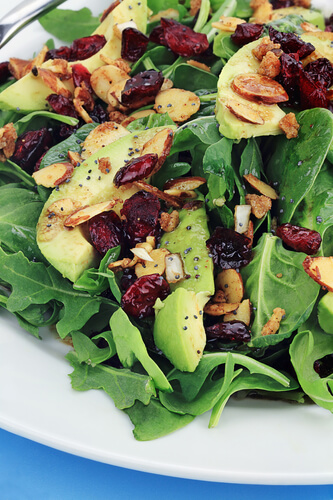
Only plant-based foods
Meat, Poultry, Fish, Milk, Eggs, Cheese, Honey
*Also avoid: leather, fur, silk, wool, soaps and cosmetics derived from animal product
Plant-based foods & Milk, Milk Products, Cheese, Yogurt
Meat, Poultry, Fish, Eggs
Plant-based foods & Milk, Milk Products, Cheese, Yogurt, Eggs
Meat, Poultry, Fish
Plant-based foods, Animals foods consumed in limited quantity and/or frequency
Occasionally consume or in limited quantity: Meat, Poultry, Fish
The fruitarian has a simpler diet consisting only of fresh fruits and some vining foods that are technically considered fruits, but have been used as vegetables. These vegetable/fruits include cucumbers, tomatoes, and avocados.
Those who follow the raw food diet include all fruits, vegetables, nuts, seeds, and soaked and sprouted grains and legumes. Further, the raw foodist does not cook or heat the foods, but eats them only in their natural, raw state in order to preserve their valuable enzymes.
Those who follow the living foods diet include a broad variety of fresh fruits, vegetables, nuts, and seeds, soaked and sprouted grains and legumes. In addition, they will warm some of their foods in a dehydrator with a temperature regulator. In order to preserve the valuable enzymes that raw foods contain, some foods can be warmed to temperatures no higher than 105 degrees, while others will tolerate a little higher heat at 115 degrees.
Avoiding the consumption of meat provides excellent physical benefits. Vegetarian diets low in fat or saturated fat have been used successfully as part of comprehensive health programs to reverse severe coronary artery disease. Vegetarian diets offers protections from disease because of their lower saturated fat, cholesterol, and animal protein content and often higher concentration of foliate (which reduces serum homocysteine levels, antioxidants such as vitamins C and E, carotenoids, and phytochemicals.)
Total serum cholesterol and low-density lipoprotein cholesterol levels are usually lower in vegetarians, but high-density lipoprotein cholesterol and triglyceride levels vary depending on the type of vegetarian diet followed.
This effect appears to be independent of both body weight and sodium intake. Type 2 diabetes mellitus is much less likely to be a cause of death in vegetarians than nonvegetarians, perhaps because of their higher intake of complex carbohydrates and lower body mass index.
Reduced colorectal cancer risk is associated with increased consumption of fiber, vegetables, and fruit. The environment of the colon differs notably in vegetarians compared with nonvegetarians in ways that could favorably affect colon cancer risk. Lower breast cancer rates have not been observed in Western vegetarians, but cross-cultural data indicate that breast cancer rates are lower in populations that consume plant-based diets. The lower estrogen levels in vegetarian women provides higher benefits.
Studies using human being and animal models suggest that some plant proteins may increase survival rates and decrease proteinuria, glomerular filtration rate, renal blood flow and histologic renal damage compared with a non-vegetarian diet.
Research suggests that complementary proteins do not need to be consumed at the same time and that consumption of various sources of amino acids over the course of the day should ensure adequate nitrogen retention in healthy persons. Although vegetarian diets are lower in total protein and a vegetarian's protein needs may be somewhat elevated because of the lower quality of some plant proteins, protein intake in both lacto-ovo-vegetarians and vegans appears to be adequate.
Even peanuts are rich in fat but have zero cholesterol. Coconuts are very rich in fat but no cholesterol. Any animal product has tremendous amounts of cholesterol. But our body does not really need the intake of cholesterol (LDL). Our liver produces healthy cholesterol (HDL). High cholesterol deposits in the body cause gallstones, gall bladder problems, rheumatoid arthritis, muscle, tendon and joint problems (not to mention heart-related diseases). When children are given cholesterol they become hyperactive or lazy; they get cancer, obesity, nervous and irritable at a younger age. It has been researched that you don't need anything more than fruits, vegetables and complex carbohydrates to provide all the nutrients in a perfect diet. If you eat three different types or varieties of complex carbohydrates per day you can get all the amino acids.
Let's discuss protein! Many people think vegans and vegetarians do not have sufficient sources of protein.
Listed as Food, Amount, and Protein Amount
Almond butter 2 tbsp 5 g
Almonds ¼ cup 8 g
Black beans, cooked 1 cup 15 g
Black-eyed peas, cooked 1 cup 11 g
Broccoli, cooked 1 cup 4 g
Brown rice, cooked 1 cup 5 g
Bulgar, cooked 1 cup 6 g
Cashews ¼ cup 5 g
Chickpeas, cooked 1 cup 12 g
Kidney beans, cooked 1 cup 13 g
Lentils, cooked 1 cup 18 g
Lima beans, cooked 1 cup 10 g
Peanut butter 2 tbsp 8 g
Peas, cooked 1 cup 9 g
Pinto beans, cooked 1 cup 12 g
Quinoa, cooked 1 cup 9 g
Seitan 3 oz 31 g
Soy milk 1 cup 7 g
Soy yogurt, plain 6 oz 6 g
Soybeans, cooked 1 cup 29 g
Spinach, cooked 1 cup 5 g
Sunflower seeds ¼ cup 6 g
Tempeh 1 cup 41 g
Tofu, firm 4 oz 11 g
Tofu, regular 4 oz 9 g
Whole wheat bread Two slices 5 g
Sources: GentleWord.org, MedicalNewsToday.com, VegetarianTimes.com, LivingWell.com, LiveStrong.com
